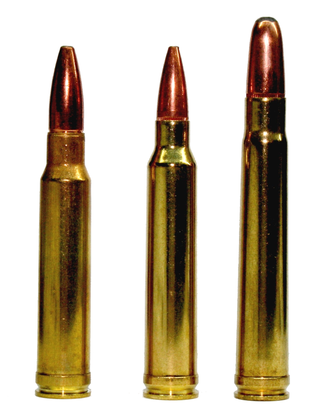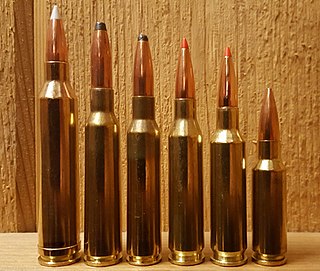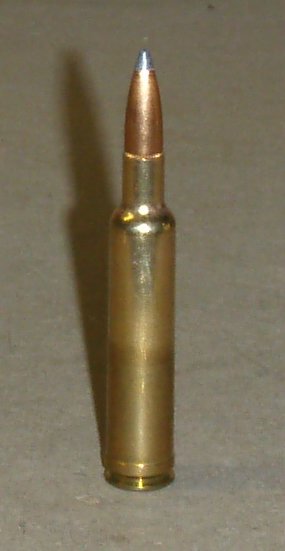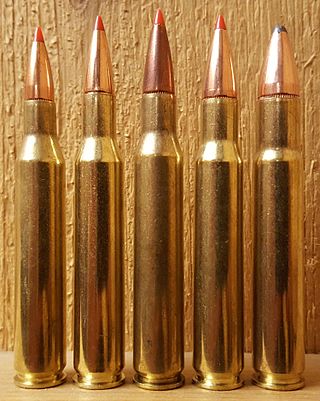Related Research Articles

This is a table of selected pistol/submachine gun and rifle/machine gun cartridges by common name. Data values are the highest found for the cartridge, and might not occur in the same load.

The .338 Lapua Magnum is a rimless, bottlenecked, centerfire rifle cartridge. It was developed during the 1980s as a high-powered, long-range cartridge for military snipers. Due to its use in the War in Afghanistan and the Iraq War, the cartridge has become widely available.

The .308 Winchester is a smokeless powder rimless bottlenecked rifle cartridge widely used for hunting, target shooting, police, military, and personal protection applications globally. It is similar, but not identical, to the 7.62×51mm NATO cartridge.

The 7mm-08 Remington is a rifle cartridge that is almost a direct copy of a wildcat cartridge developed around 1958 known as the 7mm/308. As these names would suggest, it is the .308 Winchester case necked down to accept 7 mm (.284) bullets with a small increase in case length. Of cartridges based upon the .308, it is the second most popular behind only the .243 Winchester. However, the .308 is more popular than both. In 1980, the Remington Arms company popularized the cartridge by applying its own name and offering it as a chambering for their Model 788 and Model 700 rifles, along with a limited-run series within their Model 7600 pump-action rifles during the early 2000s.

The .300 Winchester Magnum is a belted, bottlenecked Magnum rifle cartridge that was introduced by the Winchester Repeating Arms Company in 1963. The .300 Winchester Magnum is a magnum cartridge designed to fit in a standard rifle action. It is based on the .375 H&H Magnum, which has been blown out, shortened, and necked down to accept a .30 caliber (7.62 mm) bullet.

The 7mm Remington Magnum rifle cartridge was introduced as a commercially available round in 1962, along with the new Remington Model 700 bolt-action rifle. It is a member of the belted magnum family that is directly derived from the venerable .375 H&H Magnum. The original purpose of the belted magnum concept taken from the .300 H&H Magnum and .375 H&H Magnum, was to provide precise headspace control, since the sloping shoulders, while easing cartridge extraction, were unsuitable for this purpose. Improved cartridge extraction reliability is desirable while hunting dangerous game, in particular when a fast follow-up shot is required. The 7mm Remington Magnum is based on the commercial .264 Winchester Magnum, .338 Winchester Magnum, and .458 Winchester Magnum, which were based on the same belted .300 H&H Magnum and .375 H&H Magnum cases, trimmed to nearly the same length as the .270 Weatherby Magnum.

The .35 Whelen is a powerful medium-bore rifle cartridge that does not require a magnum action or a magnum bolt-face. The parent of this cartridge is the .30-06 Springfield, which is necked-up to accept a bullet diameter of .358 in (9.1 mm). This cartridge is more powerful than its parent, especially in killing power on large game. However, with much wider availability, and the higher BC .30 caliber bullets of today, the power gap between the two cartridges has been decreased.
The .260 Remington cartridge was introduced by Remington in 1997. Many wildcat cartridges based on the .308 Winchester case had existed for years before Remington standardized this round.
The .300 Lapua Magnum (7.62×70mm) is a rimless, bottlenecked, centerfire cartridge developed for long-range rifles. The parent case of the .300 Lapua Magnum is the .338 Lapua Magnum necked down to a smaller caliber. The .338 cartridge case was selected to withstand high chamber pressures. Combining these high pressures with smaller, lighter bullets than its parent case, .300 Lapua Magnum loadings have high muzzle velocities.

The .404 Jeffery is a rifle cartridge designed for hunting large, dangerous game animals, such as the "Big Five" of Africa. The cartridge is standardized by the C.I.P. and is also known as .404 Rimless Nitro Express. It was designed in 1905 by London based gunmaker W.J. Jeffery & Co to duplicate the performance of the .450/400 Nitro Express 3-inch in bolt-action rifles. The .404 Jeffery fired a bullet of .422 in (10.72 mm) diameter of either 300 gr (19 g) with a muzzle velocity of 2,600 ft/s (790 m/s) and muzzle energy of 4,500 foot-pounds force (6,100 N⋅m) or 400 gr (26 g) with a muzzle velocity of 2,150 ft/s (660 m/s) and 4,100 foot-pounds force (5,600 N⋅m) of energy. It is very effective on large game and is favored by many hunters of dangerous game. The .404 Jeffery was popular with hunters and game wardens in Africa because of its good performance with manageable recoil. By way of comparison, the .416 Rigby and .416 Remington Magnum cartridges fire .416 in (10.57 mm) bullets of 400 gr at 2,400 feet per second (730 m/s) with a muzzle energy of approximately 5,000 foot-pounds force (6,800 N⋅m). These cartridges exceed the ballistic performance of the .404 Jeffery but at the price of greater recoil and, in the case of the .416 Rigby, rifles that are more expensive.

The .284 Winchester is a firearm cartridge, introduced by Winchester in 1963.

The .338 Remington Ultra Magnum is a .338 caliber rifle cartridge introduced by Remington Arms in 2002.

The 6.5mm Creedmoor (6.5×48mm), designated 6.5 Creedmoor by SAAMI, 6.5 Creedmoor by the C.I.P. or 6.5 CM or 6.5 CRDMR for short, is a centerfire rifle cartridge introduced by Hornady in 2007. It was developed by Hornady senior ballistics scientist Dave Emary in partnership with Dennis DeMille, the vice-president of product development at Creedmoor Sports, hence the name. The cartridge is a necked-down modification of the .30 Thompson Center.

The 7mm Weatherby Magnum is a powerful 7mm rifle cartridge offered by the Weatherby firearms company in their Mark V rifles. The cartridge was one of the first cartridges offered by the Weatherby company.

The .338 Norma Magnum is a cartridge first introduced in 2008 and came into production in 2009, designed by Norma of Sweden.
The .338 Xtreme cartridge, is based on a necked down .505 Gibbs cartridge case with a sharper 35 degree shoulder angle. Introduced in 2008 by Xtreme Machining of Grassflat, Pa, the cases, commercially produced by Bertram Bullets, have a length of 3.030" and a head diameter of 0.640". Case capacity is 167.5 grains. Factory loads drive a 266 grain bullet at 3350 feet per second from a 30" barrel. The factory loads are loaded with a Tellurium Copper alloy solid very-low-drag bullet, These projectiles are manufactured by Xtreme Machining and of a patent pending design. The secant ogive projectile measures 1.808" long, including a 6 degree boat tail of 0.285". The patent refers to a "dual diameter" aspect of the projectile, where the main cylindrical portion of the bullet measures 0.331", 0.001" greater than the lands of the rifling. About 1.440" from the tip, the diameter increases to 0.338", creating a 0.15" "driving band". This both reduces driving force required for the high muzzle velocity as well as improves accuracy.

.30-06 Springfield wildcat cartridges are cartridges developed from a 30-06 Springfield "parent cartridge" through narrowing or widening the cartridge neck to fit a smaller or larger bullet in an attempt to improve performance in specific areas. Such wildcat cartridges are not standardized with recognized small arms standardization bodies like the SAAMI and the CIP.

The M2010 Enhanced Sniper Rifle (ESR), formerly known as the XM2010 and M24 Reconfigured Sniper Weapon System, is a sniper rifle developed by PEO Soldier for the United States Army. It is derived from and replaced the M24 Sniper Weapon System, and was designed to give snipers longer range in the mountainous and desert terrain of the War in Afghanistan. After winning a competitive bidding process, Remington was awarded the production contract for up to 3,600 weapons. The Army had anticipated sending the upgraded weapons to deployed snipers in late 2010, but later expected fielding would happen in January 2011. The M2010 fires .300 Winchester Magnum (7.62×67mm) ammunition, which offers about 50 percent more effective range than the M24's 7.62×51mm NATO. This chambering to dimensionally larger cartridges is possible because the M24 was designed to use the "long action" bolt version of the Remington 700 receiver for cartridges up to 3.34 inches (84.84 mm) in overall length.

A rifle cartridge is a firearm cartridge primarily designed and intended for use in a rifle/carbine, or machine gun.
References
- ↑ Carlock, Shawn. "338 Edge – History and Development". Len Backus' Long Range Hunting online magazine. Archived from the original on 1 November 2010. Retrieved 22 September 2010.
- ↑ ".338 300 gr HPBT ballistics". Sierra Bullets. Archived from the original on 31 January 2019. Retrieved 1 February 2019.
- ↑ "338 Edge History & Development". Defensive Edge. Archived from the original on 2 July 2010. Retrieved 22 September 2010.
- October 2000 issue of "The Accurate Rifle"